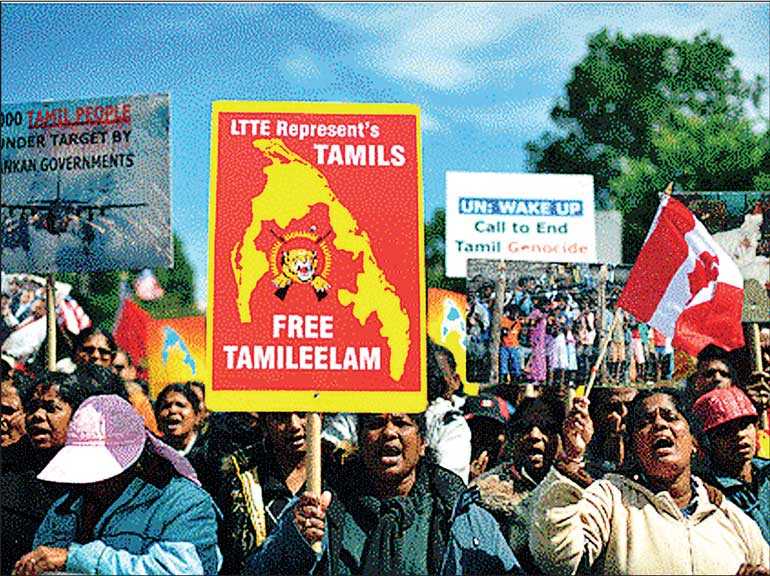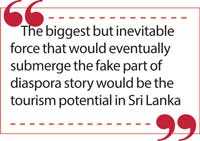Saturday Apr 26, 2025
Saturday Apr 26, 2025
Tuesday, 26 November 2019 00:00 - - {{hitsCtrl.values.hits}}

Sri Lanka is entering another era with fresh hopes, vigour and readiness to usher in an economic growth and prosperity while expecting to move at a rapid pace in the investment drive, exports and  tourism noting that in the past, most countries in South Asia have overtaken Sri Lanka in many fronts.
tourism noting that in the past, most countries in South Asia have overtaken Sri Lanka in many fronts.
The issue of adverse propaganda by the factions of Sri Lankan pro-LTTE Tamil diaspora is viewed in light of the new political scenario while Sri Lanka has so far positively countered hostile publicity, through diplomatic and other patriotic channels. The likes of TGTE, TCC CTC GTF are yet to see the inevitable forces that would diminish their voice in the next decade or so.
The cyber space that had helped the LTTE propaganda once, is becoming counterproductive with today’s dynamism of independent views which the current pro LTTE forces cannot evade. For instance, Wiki page of LTTE itself states, it was designated as a terrorist organisation by 32 countries, including the EU, Canada, the US, and India and it was known for using women and children in combat and is recognised for having carried out a number of high-profile assassinations.
With an average economic growth of 7% in the coming years, they say, Sri Lanka could rest assured on the question of reconciliation using the Malaysian model that the identification of Bhumi Putras was not an issue when every family could afford a house, car, school for children, medical facility and a mobile phone! An easy way to approach the concept of harmony among ethnic communities.
Prof. Rohan Gunaratne when addressing an intelligence unit in Scandinavia way back in 2003 said that LTTE had to be defeated militarily at a time the peace talks became noticeably breathing space for the LTTE.
It was proved to be true years later as the last and only option for peace and to rescue the Tamil civilians used as a human shield.
This message has gotten across to the world firmly which cannot be erased even in the future when the open cyber sources report the LTTE closed the sluice gates of the Mavil Oya (Mavil Aru) reservoir on 21 July 2006, and cut the water supply to 15,000 villages in Government-controlled areas. This dispute developed into a full-scale war by August 2006. This is not what the Government says or a version of Sinhalese.
A presence of a self-proclaimed Prime Minister of the so-called Transnational Government would not have much of a meaning to the third generation of Tamil diaspora community meaning that their priorities would be to go after their individual goals rather than digging into the past and hero worshipping. The pro-LTTE members of yesteryear would only be recognised until their vote is important to the local politicians in their respective constituencies.
The message that the investors who had confidence in Sri Lanka had given to the international community after the war ended in 2009 is quite clear. Apart from the April setback, Sri Lanka could boost the investment drive in various fields especially in the knowledge-based services.
It is therefore proper to repeat the words of Lord Neseby that the diaspora should be helping Sri Lanka instead of complaining!
The biggest but inevitable force that would eventually submerge the fake part of diaspora story would be the tourism potential in Sri Lanka. The tourist, a holiday maker or businessman, is a powerful communicator with an independent opinion especially those from the countries where the diaspora community is active.
It is one robust attribute of tourism to project true ground reality in Sri Lanka hence the need to see tourism beyond its known definition.
The usual projection through tourism entails authenticity, diversity in compactness in
Sri Lanka and the suggestion is to entrench the theme to cover that Sri Lanka does not have an ethnic issue except that all LTTE happened to be Tamils and that the occurrence of Sinhala only in the 50s or July riots of the 80s were political blunders for which successive Governments cannot be held responsible.
The contribution of tourism in image correction and image building efforts cannot be measured in terms of monetary value. If one considers this aspect in an overall plan of action for countering bad publicity, tourism will compliment all the endeavours by the diplomats countering false propaganda if the promotion is extended to the ones who are already in the country holidaying.
The visits to Northern and Eastern regions by tourists will communicate a strong message that the country is a long way off the bad times. 
The future beneficiaries in these areas in tourism would be the Tamil communities and it is grave injustice on the part of the diaspora to hide this fact from the international community.
Travel writers, foreign tour operators, holiday makers, incentive travellers, business and conference delegates, celebrities, and bloggers are all foreigners who are members of the target audience in tourism promotional campaigns. The primary tourism source markets include UK, Germany, France and other European countries. The message that the visitors relate carry the highest credibility over what the Sri Lankans could report through advertising and press releases.
With any chance of a direct flight to Canada (presumably not hither to feasible in commercial terms), the second and third generation of the diaspora will observe how life goes on in Sri Lanka after the war ended. At the same time , Sri Lanka has probably ignored a large percentage of the silent moderates and specially the members of once armed groups viz PLOTE, TELO, EPRLF, EPDP etc. who fled the country to escape LTTE atrocities.
For instance, there is one family with four daughters and mother fled to Scandinavia when their only male brother was killed by the LTTE for refusing to collaborate.
Sadly and helplessly, they had to say they were fleeing from the Government forces to become refugees in the country where they are settled now.
There is a large such moderate community who are living in the west. Some way of activating them seems necessary, not necessarily to counter pro-LTTE propaganda but to see Sri Lanka as a place for investments thus secure their mindset that Sri Lanka is their first home.
Tourism is therefore reckoned as a primary tool in communication that can offset negative publicity. With the opening of the North and East to the visitors, it will be very hard for propaganda like Channel 4 to tarnish what Sri Lanka offers as a unique experience which consists of culture that embraces people of all communities in which there is no place for extremists to operate unless carrying labels as PMS and ministers of transnational governments!
(The writer is a former Diplomat, Tourism Official and currently an academic.)
Discover Kapruka, the leading online shopping platform in Sri Lanka, where you can conveniently send Gifts and Flowers to your loved ones for any event including Valentine ’s Day. Explore a wide range of popular Shopping Categories on Kapruka, including Toys, Groceries, Electronics, Birthday Cakes, Fruits, Chocolates, Flower Bouquets, Clothing, Watches, Lingerie, Gift Sets and Jewellery. Also if you’re interested in selling with Kapruka, Partner Central by Kapruka is the best solution to start with. Moreover, through Kapruka Global Shop, you can also enjoy the convenience of purchasing products from renowned platforms like Amazon and eBay and have them delivered to Sri Lanka.
Discover Kapruka, the leading online shopping platform in Sri Lanka, where you can conveniently send Gifts and Flowers to your loved ones for any event including Valentine ’s Day. Explore a wide range of popular Shopping Categories on Kapruka, including Toys, Groceries, Electronics, Birthday Cakes, Fruits, Chocolates, Flower Bouquets, Clothing, Watches, Lingerie, Gift Sets and Jewellery. Also if you’re interested in selling with Kapruka, Partner Central by Kapruka is the best solution to start with. Moreover, through Kapruka Global Shop, you can also enjoy the convenience of purchasing products from renowned platforms like Amazon and eBay and have them delivered to Sri Lanka.